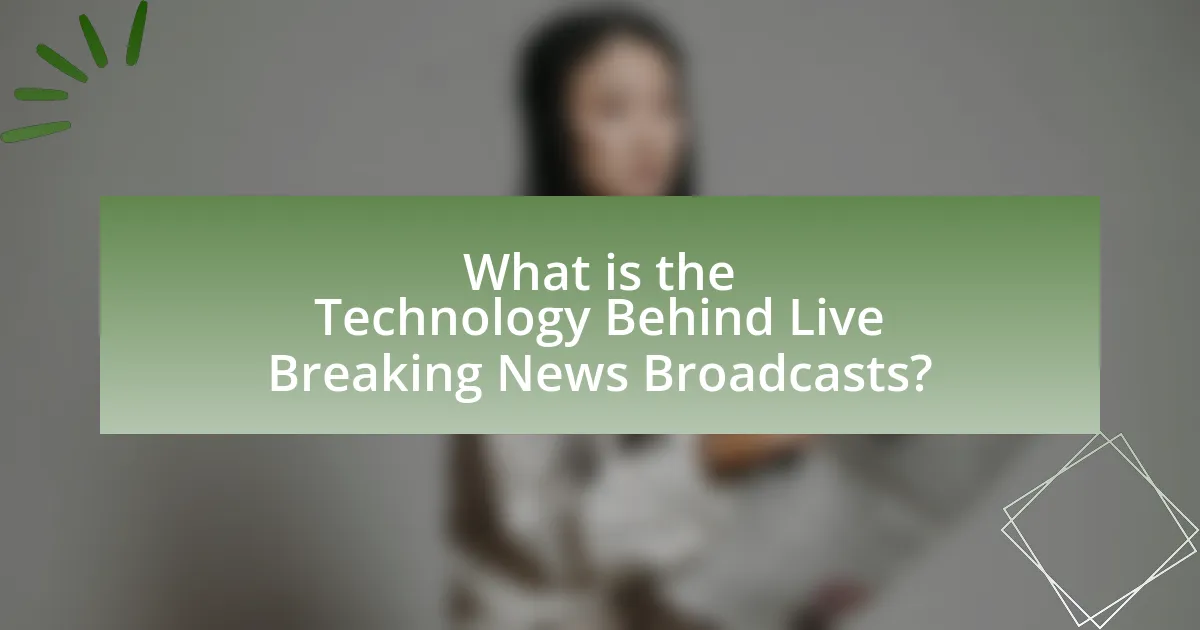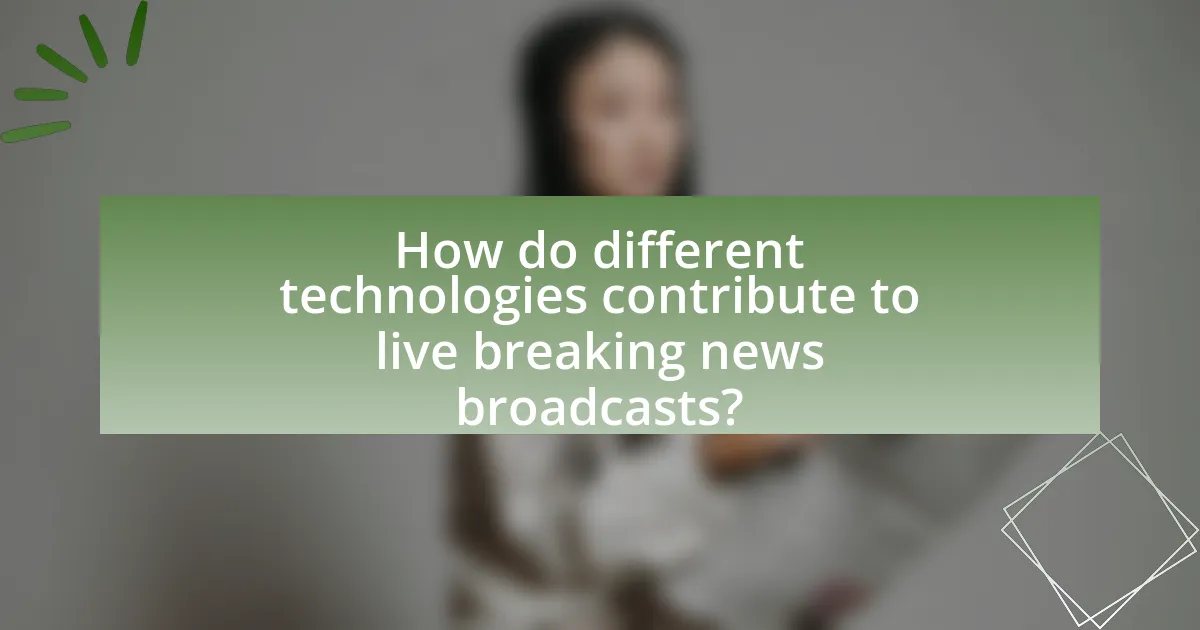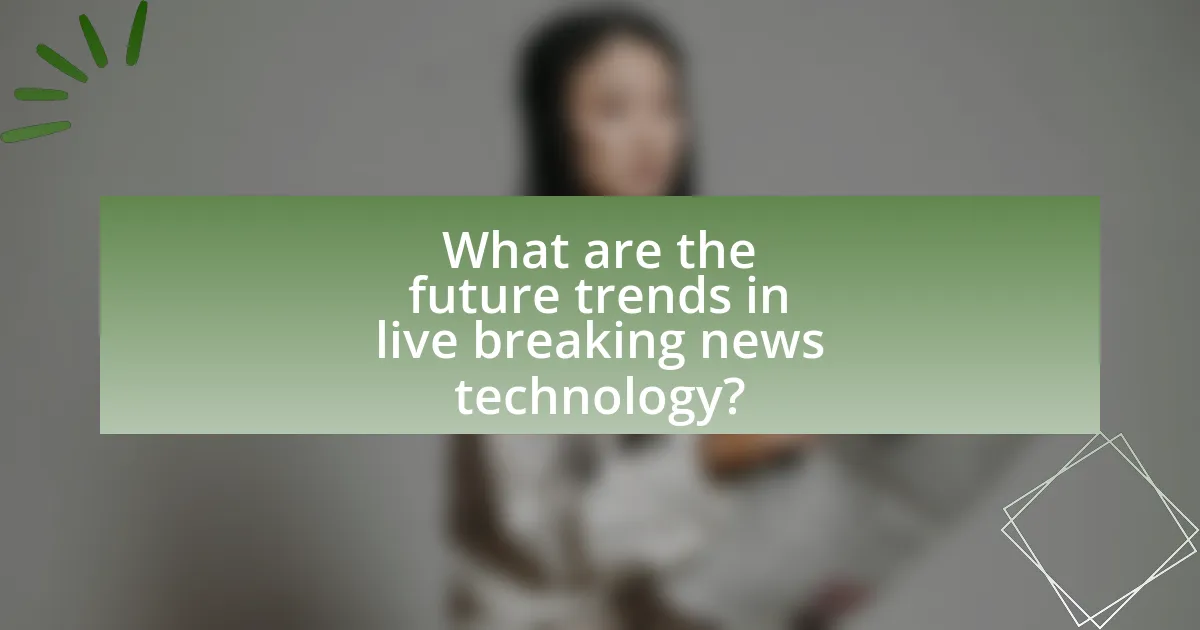The article focuses on the technology behind live breaking news broadcasts, highlighting key components such as satellite communication, fiber optics, and mobile broadcasting units. It discusses the evolution of news broadcasting technology, emphasizing advancements like high-definition video transmission and mobile journalism, which enhance real-time reporting and audience engagement. The article also examines the role of artificial intelligence and virtual reality in shaping the future of news delivery, while addressing challenges such as misinformation and the need for accuracy in reporting. Overall, it provides a comprehensive overview of how these technologies transform the landscape of live news broadcasting.

What is the Technology Behind Live Breaking News Broadcasts?
The technology behind live breaking news broadcasts primarily involves satellite communication, fiber optics, and mobile broadcasting units. Satellite communication enables real-time transmission of video and audio signals from remote locations to broadcasting stations, ensuring coverage of events as they unfold. Fiber optics provide high-speed data transfer, allowing for the rapid delivery of news content to viewers. Additionally, mobile broadcasting units equipped with advanced cameras and transmission equipment facilitate on-the-ground reporting, enhancing the immediacy and accessibility of breaking news. These technologies collectively ensure that news organizations can deliver timely and accurate information to the public.
How has technology evolved in live news broadcasting?
Technology in live news broadcasting has evolved significantly from traditional methods to advanced digital platforms. Initially, live broadcasts relied on satellite and terrestrial transmission, which limited accessibility and required extensive infrastructure. The introduction of digital technology, including high-definition video and internet streaming, has transformed the landscape, allowing for real-time broadcasting from virtually anywhere.
For instance, the advent of mobile journalism, where reporters use smartphones equipped with high-quality cameras and editing software, has enabled immediate coverage of breaking news events. According to a 2020 report by the Pew Research Center, 53% of U.S. adults now get news from social media, highlighting the shift towards digital platforms for news dissemination. Additionally, advancements in artificial intelligence and data analytics have enhanced the ability to gather and analyze information quickly, improving the accuracy and speed of news reporting.
These technological advancements have not only increased the speed of news delivery but also expanded the reach and engagement of audiences globally.
What are the key technological advancements in this field?
Key technological advancements in live breaking news broadcasts include the development of high-definition video transmission, satellite communication, and mobile reporting technologies. High-definition video transmission has significantly improved the clarity and quality of live broadcasts, allowing viewers to experience events in greater detail. Satellite communication enables real-time broadcasting from remote locations, ensuring that news coverage is not limited by geographical constraints. Additionally, mobile reporting technologies, such as smartphones equipped with advanced cameras and live-streaming capabilities, empower journalists to report news instantly from the field, enhancing the immediacy and accessibility of information. These advancements collectively transform how news is delivered and consumed, making it more dynamic and responsive to unfolding events.
How do these advancements impact news delivery?
Advancements in technology significantly enhance news delivery by enabling real-time reporting and broader audience reach. For instance, the integration of mobile journalism tools allows reporters to broadcast live updates from the field, ensuring that audiences receive timely information during breaking news events. According to a 2021 Pew Research Center study, 53% of U.S. adults reported getting news from social media, highlighting the shift towards digital platforms for news consumption. This transition not only accelerates the dissemination of information but also fosters greater engagement through interactive features such as live comments and shares, thereby transforming how news is experienced and consumed.
What are the essential components of live breaking news technology?
The essential components of live breaking news technology include real-time data acquisition systems, high-speed internet connectivity, mobile reporting tools, and advanced broadcasting software. Real-time data acquisition systems enable journalists to gather information instantly from various sources, ensuring timely updates. High-speed internet connectivity is crucial for transmitting live video and audio feeds without delays. Mobile reporting tools, such as smartphones and tablets equipped with broadcasting apps, allow reporters to deliver news from the field efficiently. Advanced broadcasting software facilitates the integration of graphics, live feeds, and social media updates, enhancing viewer engagement. These components collectively ensure that news organizations can deliver accurate and timely information to the public during breaking news events.
What role do cameras and audio equipment play?
Cameras and audio equipment are essential for capturing and transmitting live breaking news. Cameras provide visual content that conveys information and engages viewers, while audio equipment ensures clear sound quality, allowing for effective communication of news reports. The integration of high-definition cameras and advanced microphones enhances the overall production quality, making broadcasts more professional and impactful. For instance, according to a study by the Pew Research Center, 73% of viewers consider video quality crucial for their engagement with news content, highlighting the importance of these technologies in delivering timely and accurate information.
How do transmission methods affect broadcast quality?
Transmission methods significantly impact broadcast quality by influencing signal clarity, reliability, and latency. For instance, digital transmission methods, such as satellite and fiber optics, provide higher bandwidth and better error correction compared to analog methods, resulting in clearer images and sound. Research indicates that satellite transmission can achieve up to 99.9% reliability, while traditional analog methods often suffer from interference and signal degradation. Additionally, the choice of compression techniques in transmission affects the quality; for example, H.264 compression allows for high-quality video at lower bitrates, enhancing the viewing experience during live broadcasts.
Why is real-time reporting crucial in live news broadcasts?
Real-time reporting is crucial in live news broadcasts because it ensures that audiences receive the most current and accurate information as events unfold. This immediacy allows news organizations to provide timely updates, which is essential during fast-developing situations such as natural disasters, political events, or emergencies. For instance, during the 2020 COVID-19 pandemic, real-time reporting enabled news outlets to deliver up-to-the-minute statistics and guidelines, significantly impacting public awareness and response. The ability to report in real-time enhances viewer engagement and trust, as audiences rely on news sources to keep them informed about critical developments as they happen.
How does technology facilitate real-time updates?
Technology facilitates real-time updates through the use of advanced communication systems, data processing algorithms, and internet connectivity. These systems enable instant transmission of information from various sources, such as social media, sensors, and news agencies, to broadcasting platforms. For instance, satellite communication allows news organizations to relay live footage from remote locations, while mobile applications provide users with immediate alerts on breaking news. The integration of artificial intelligence and machine learning further enhances the speed and accuracy of news dissemination by analyzing vast amounts of data in real-time, ensuring that audiences receive timely and relevant updates.
What challenges do broadcasters face in maintaining real-time accuracy?
Broadcasters face significant challenges in maintaining real-time accuracy due to the rapid pace of news cycles, technological limitations, and the potential for misinformation. The fast-paced nature of breaking news requires immediate reporting, which can lead to errors if information is not thoroughly verified. Additionally, reliance on technology, such as satellite feeds and social media, can introduce delays or inaccuracies in data transmission. For instance, a study by the Pew Research Center found that 64% of journalists reported experiencing pressure to publish quickly, which can compromise accuracy. Furthermore, the prevalence of misinformation on social media platforms complicates the verification process, as broadcasters must discern credible sources from unreliable ones.

How do different technologies contribute to live breaking news broadcasts?
Different technologies significantly enhance live breaking news broadcasts by enabling real-time reporting, improving communication, and facilitating audience engagement. For instance, satellite technology allows news organizations to transmit live video feeds from remote locations, ensuring timely coverage of events as they unfold. Additionally, mobile reporting tools, such as smartphones equipped with high-quality cameras and internet connectivity, empower journalists to capture and share news instantly from the field. Social media platforms further contribute by providing a space for immediate audience interaction and feedback, allowing news outlets to gauge public sentiment and disseminate information rapidly. According to a 2021 Pew Research Center study, 53% of U.S. adults reported getting news from social media, highlighting its role in modern news dissemination. These technologies collectively ensure that breaking news reaches audiences quickly and effectively, maintaining the relevance and immediacy of news coverage.
What is the role of satellite technology in news broadcasting?
Satellite technology plays a crucial role in news broadcasting by enabling real-time transmission of video and audio signals from remote locations to broadcasting stations. This technology allows news organizations to cover breaking news events live, regardless of geographical barriers. For instance, satellites facilitate the delivery of high-definition video feeds from conflict zones or natural disaster sites, ensuring timely and accurate reporting. According to the Satellite Industry Association, satellite communications account for a significant portion of global broadcasting, providing essential infrastructure for news networks to maintain their operations and reach audiences worldwide.
How does satellite technology enhance coverage in remote areas?
Satellite technology enhances coverage in remote areas by providing reliable communication links that are not dependent on terrestrial infrastructure. This technology enables broadcasters to transmit live video and audio feeds from locations that lack traditional connectivity, such as rural or disaster-stricken regions. For instance, satellites can deliver high-speed internet and broadcasting capabilities to remote locations, allowing news organizations to report in real-time. According to the International Telecommunication Union, satellite communication can reach 100% of the Earth’s surface, making it an essential tool for ensuring that news coverage is accessible even in the most isolated areas.
What are the limitations of satellite technology in live broadcasts?
Satellite technology in live broadcasts has several limitations, including latency, signal degradation, and high costs. Latency occurs due to the time it takes for signals to travel to and from satellites, which can result in delays of up to several seconds, affecting real-time communication. Signal degradation can happen due to atmospheric conditions, such as rain or snow, which can disrupt the clarity and reliability of the broadcast. Additionally, the high costs associated with satellite equipment and maintenance can limit accessibility for smaller broadcasters. These factors collectively hinder the effectiveness and efficiency of satellite technology in delivering live broadcasts.
How do mobile technologies impact live news reporting?
Mobile technologies significantly enhance live news reporting by enabling real-time coverage and immediate dissemination of information. Journalists can use smartphones and tablets equipped with high-quality cameras and internet access to report from the field, allowing for instant updates and live streaming. According to a Pew Research Center study, 62% of Americans get news on social media, highlighting the role of mobile platforms in reaching audiences quickly. This immediacy not only increases audience engagement but also allows news organizations to respond rapidly to breaking events, thereby shaping public discourse in real-time.
What advantages do smartphones and tablets offer to reporters?
Smartphones and tablets provide reporters with mobility, instant access to information, and efficient communication tools. These devices enable journalists to capture high-quality photos and videos on-site, facilitating real-time reporting. Additionally, they allow for quick dissemination of news through social media and news apps, reaching audiences faster than traditional methods. According to a 2021 Pew Research study, 86% of journalists reported using mobile devices for reporting, highlighting their essential role in modern journalism.
How do mobile apps facilitate news dissemination?
Mobile apps facilitate news dissemination by providing instant access to real-time updates and notifications. These applications enable users to receive breaking news alerts, stream live broadcasts, and access articles from various sources, all in one platform. According to a Pew Research Center study, 86% of Americans get their news from mobile devices, highlighting the significant role these apps play in shaping news consumption habits. Furthermore, mobile apps often incorporate social sharing features, allowing users to easily share news articles with their networks, thereby amplifying the reach of information.
What is the significance of social media in live news broadcasts?
Social media plays a crucial role in live news broadcasts by providing real-time updates and facilitating audience engagement. It allows news organizations to disseminate information rapidly, reaching a global audience instantly. For instance, during significant events like natural disasters or political protests, platforms such as Twitter and Facebook enable journalists to share live updates, images, and videos, enhancing the immediacy of news coverage. According to a Pew Research Center study, 62% of adults in the U.S. get news from social media, highlighting its importance as a primary news source. Additionally, social media fosters interaction, allowing viewers to comment, share, and discuss news stories, which can influence public perception and drive further coverage.
How do social media platforms influence audience engagement?
Social media platforms significantly influence audience engagement by providing real-time interaction and content sharing capabilities. These platforms enable users to comment, like, and share news updates instantly, fostering a sense of community and immediacy. For instance, studies show that posts with high engagement rates can increase visibility and reach, as algorithms prioritize content that generates interaction. According to a report by Pew Research Center, 53% of adults in the U.S. say they often get news from social media, highlighting its role in shaping audience engagement with current events.
What challenges do journalists face when using social media for news reporting?
Journalists face several challenges when using social media for news reporting, including misinformation, rapid information dissemination, and audience engagement. Misinformation can spread quickly on social media platforms, making it difficult for journalists to verify facts before reporting. A study by the Pew Research Center found that 64% of Americans believe that fabricated news stories cause confusion about the basic facts of current events. Additionally, the speed at which information circulates on social media can pressure journalists to publish stories quickly, potentially sacrificing accuracy for timeliness. Furthermore, engaging with audiences on social media requires journalists to navigate complex interactions, including managing public comments and addressing criticism, which can detract from their primary reporting responsibilities.

What are the future trends in live breaking news technology?
Future trends in live breaking news technology include the increased use of artificial intelligence for real-time content generation and enhanced audience engagement through interactive platforms. AI algorithms are being developed to analyze data and generate news stories quickly, allowing news organizations to provide timely updates during breaking events. Additionally, augmented reality and virtual reality technologies are being integrated into broadcasts, offering immersive experiences that engage viewers more deeply. According to a report by the Reuters Institute for the Study of Journalism, 60% of news organizations are investing in AI to improve their reporting capabilities, highlighting the industry’s shift towards technology-driven news delivery.
How is artificial intelligence shaping the future of news broadcasting?
Artificial intelligence is transforming news broadcasting by enhancing content creation, personalization, and distribution efficiency. AI algorithms analyze vast amounts of data to generate news articles, enabling faster reporting and reducing human error. For instance, the Associated Press uses AI to automate the writing of earnings reports, producing thousands of articles quickly and accurately. Additionally, AI-driven analytics help broadcasters understand audience preferences, allowing for tailored content delivery that increases viewer engagement. According to a 2021 report by the Reuters Institute, 60% of news organizations are investing in AI technologies to improve their operations, indicating a significant shift towards AI integration in the industry.
What applications of AI are emerging in live news reporting?
Emerging applications of AI in live news reporting include automated content generation, real-time data analysis, and enhanced audience engagement through personalized news delivery. Automated content generation utilizes natural language processing to create news articles quickly, allowing news organizations to cover breaking stories as they unfold. Real-time data analysis enables journalists to process vast amounts of information from various sources, such as social media and live feeds, to provide timely updates and context. Additionally, AI-driven algorithms can analyze viewer preferences and behaviors to tailor news content, ensuring that audiences receive relevant information. These advancements are supported by the increasing integration of AI technologies in media organizations, enhancing the efficiency and effectiveness of news reporting.
How might AI improve the accuracy of news coverage?
AI can improve the accuracy of news coverage by utilizing advanced algorithms to analyze vast amounts of data in real-time, identifying trends and verifying facts more efficiently than human reporters. For instance, AI systems can cross-reference information from multiple reliable sources, reducing the likelihood of misinformation. A study by the Reuters Institute for the Study of Journalism found that news organizations employing AI tools reported a 30% increase in fact-checking efficiency, leading to more accurate reporting. Additionally, AI can monitor social media platforms for breaking news, allowing journalists to verify information quickly and accurately, thus enhancing the overall reliability of news coverage.
What role does virtual reality play in the future of news broadcasts?
Virtual reality (VR) is poised to revolutionize news broadcasts by providing immersive experiences that enhance viewer engagement and understanding. By allowing audiences to experience news events as if they were physically present, VR can convey the emotional weight and context of stories more effectively than traditional media. For instance, a study by the University of Southern California found that VR can increase empathy among viewers, making them more connected to the news being presented. This technology enables journalists to create interactive environments where users can explore scenes, interact with elements, and gain a deeper insight into complex issues, thereby transforming the way news is consumed and understood.
How can virtual reality enhance viewer experience in news reporting?
Virtual reality can enhance viewer experience in news reporting by providing immersive environments that allow audiences to engage with news stories on a deeper level. This technology enables viewers to feel as if they are present at the scene of events, which can lead to a more emotional and impactful understanding of the news. For instance, a study by the University of Southern California found that virtual reality can increase empathy and retention of information, as users are more likely to remember details when they experience them in a simulated environment. By placing viewers in the midst of significant events, virtual reality transforms traditional news consumption into an interactive experience, fostering a stronger connection to the content.
What are the potential challenges of integrating virtual reality into live broadcasts?
Integrating virtual reality into live broadcasts presents several potential challenges, including technical limitations, viewer accessibility, and content creation complexities. Technical limitations arise from the need for high bandwidth and low latency to deliver immersive experiences in real-time, which can strain existing broadcasting infrastructure. Viewer accessibility is another challenge, as not all audiences possess the necessary VR equipment or familiarity with the technology, potentially alienating segments of the audience. Additionally, content creation complexities involve the need for specialized skills and resources to produce engaging VR content that effectively complements live broadcasts, which can increase production costs and time. These challenges highlight the multifaceted obstacles that broadcasters must navigate when incorporating virtual reality into their offerings.
What best practices should broadcasters follow for effective live reporting?
Broadcasters should prioritize clarity, accuracy, and audience engagement for effective live reporting. Clarity ensures that the information is easily understood, which is crucial during fast-paced news events. Accuracy is vital, as misinformation can lead to public panic or confusion; for instance, the Associated Press emphasizes the importance of fact-checking in real-time reporting. Audience engagement can be enhanced through interactive elements, such as social media integration, allowing viewers to participate and share their perspectives. These best practices collectively contribute to a more informed and engaged audience during live broadcasts.
How can technology be leveraged to improve viewer trust in news broadcasts?
Technology can be leveraged to improve viewer trust in news broadcasts by implementing real-time fact-checking systems and enhancing transparency through data visualization. Real-time fact-checking tools, such as automated verification algorithms, can assess the accuracy of information as it is reported, thereby reducing the spread of misinformation. For instance, platforms like FactCheck.org utilize technology to provide immediate verification of claims made during broadcasts, which can significantly enhance credibility. Additionally, data visualization tools can present complex information in an easily digestible format, allowing viewers to understand the context and sources behind news stories. This approach not only clarifies the information but also fosters a sense of accountability among news organizations, as seen in the use of interactive graphics by outlets like The New York Times to illustrate data-driven stories.
What strategies can enhance the reliability of live news reporting?
Implementing fact-checking protocols enhances the reliability of live news reporting. Fact-checking involves verifying information before broadcasting, which reduces the spread of misinformation. For instance, organizations like PolitiFact and FactCheck.org provide real-time verification services that news outlets can utilize during live reporting. Additionally, employing multiple sources for information corroboration ensures accuracy; studies show that cross-referencing data from various credible sources significantly lowers the chances of reporting errors. Training journalists in crisis communication and ethical reporting standards further strengthens the integrity of live broadcasts, as evidenced by the adherence to guidelines set by the Society of Professional Journalists.




